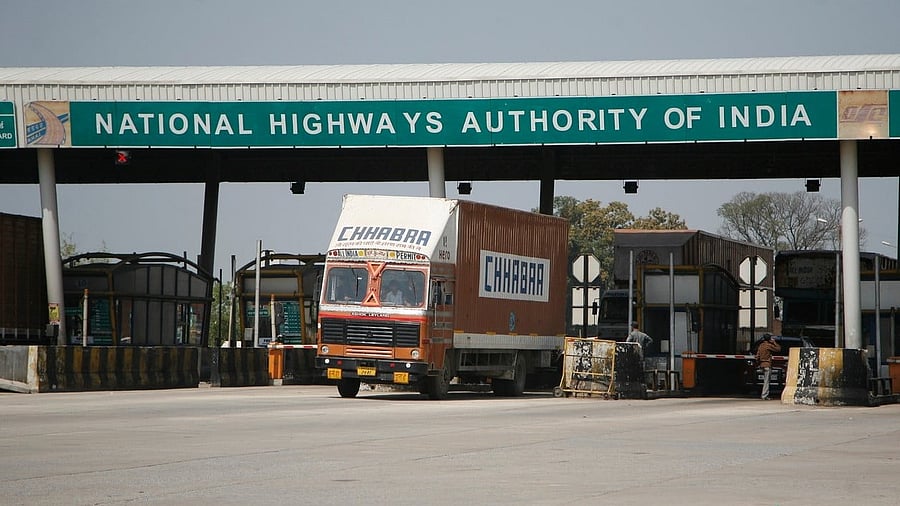
Representative image of a toll booth
Credit: iStock Photo
The Ministry of Road Transport and Highways (MoRTH) on Friday clarified that no decision has been taken on the nationwide implementation of satellite-based tolling from May 1. This comes after reports floated that a satellite-based tolling system would be launched from May 1, 2025, and will replace the existing FASTag-based toll collection system.
These reports were triggered after Union Minister Nitin Gadkari recently revealed that the Modi government is soon going to roll out a new toll policy that will nullify all the complaints people have regarding toll booths. It was assumed that the new system that will be rolled out in the next 15 days is the Global Navigation Satellite System (GNSS).
However, the ministry clarified that instead of GNSS, to enable seamless, barrier-free movement of vehicles through toll plazas and reduce travel time, an ‘Automatic Number Plate Recognition (ANPR)-FASTag-based barrier-less tolling system’ will be implemented at selected toll plazas.
Here is all you need to know about ‘Automatic Number Plate Recognition (ANPR)-FASTag-based barrier-less tolling system and the Global Navigation Satellite System.
What is ANPR?
According to the statement, the advanced tolling system will combine Automatic Number Plate Recognition (ANPR) technology, which will identify vehicles by reading their number plates, and the existing ‘FASTag system’ that uses Radio-Frequency Identification (RFID) for toll deduction.
How will vehicles be charged under ANPR?
Under this, vehicles will be charged based on their identification through high performance ANPR cameras and FASTag readers, without needing to stop at the toll plazas.
In case of non-compliance, e-notices will be served to the violators, non-payment of which may result in suspension of FASTag and other VAHAN related penalties.
What is GNSS and how does it work?
A barrier-free method of tolling, under the Global Navigation Satellite System (GNSS), a road user is charged based on the distance that they have traveled on the tolled highway stretch.
The system involves automatic deductions from bank accounts using satellite tracking and vehicle number plate recognition, eliminating the need for manual toll collection.
Benefits of GNSS and ANPR
Under both systems, commuters would no longer have to stop at booths, saving them time. Unlike the existing FASTag system, where there are chances that a vehicle pileup may occur in case of technical errors.
However, under GNSS, due to its satellite tracking system there will be a reduction in the chances of a human error and fraud.
How is GNSS different from FASTag?
While FASTag required the driver to wait at toll booths, there would be no need to make physical stop with GNSS as it relies on virtual booths using satellite technology. Moreover, unlike FASTag, where a prepaid balance was required to make payment from the account, GNSS offers both pre-, and post-paid options.
Given its reliance on satellite technology, GNSS is more accurate in calculating toll payments.
When it comes to technology, FASTag uses Radio Frequency Identification to scan the sticker on the car vehicle's windshield. Meanwhile, GNSS relies on Global Navigation Satellite System, which includes GPS, to track the location of the vehicle and the distance traveled.
When did GNSS come in the picture, and what may have caused the confusion?
"The central government will soon introduce a new toll policy. I will not speak much about it now, but within the next 15 days, a new policy will be announced. Once implemented, there will be no reason for anyone to complain about tolls," Nitin Gadkari had said in Mumbai on April 15.
The new system would involve automatic deductions from bank accounts using satellite tracking and vehicle number plate recognition, eliminating the need for manual toll collection, he had added.
However, this is not the first mention of GNSS.
In August 2022, the government had organised a workshop on Global Navigation Satellite System (GNSS) based tolling, which aimed to help the government strategise and design the roadmap for free-flow tolling system in the country.
"The objective of the workshop was to seek input and suggestions from various industry experts and stakeholders on different aspects of the GNSS-based tolling system.
Various stakeholders, including relevant government departments, ISRO, NIC, and industry players such as vehicle manufacturers, AIS-140 On-Board Unit (OBU) manufacturers, Global GNSS service providers, banks, payment aggregators/ gateway service providers, were invited for deliberations.
Meanwhile, last year in February, the government had appointed a consultant for implementing GPS-based toll collection system on national highways.
The Road Transport and Highways Minister had said that the system will be introduced on a pilot basis in addition to FASTags.
However, after today's statement, there is no clarity on GNSS implementation.
(With PTI inputs)
